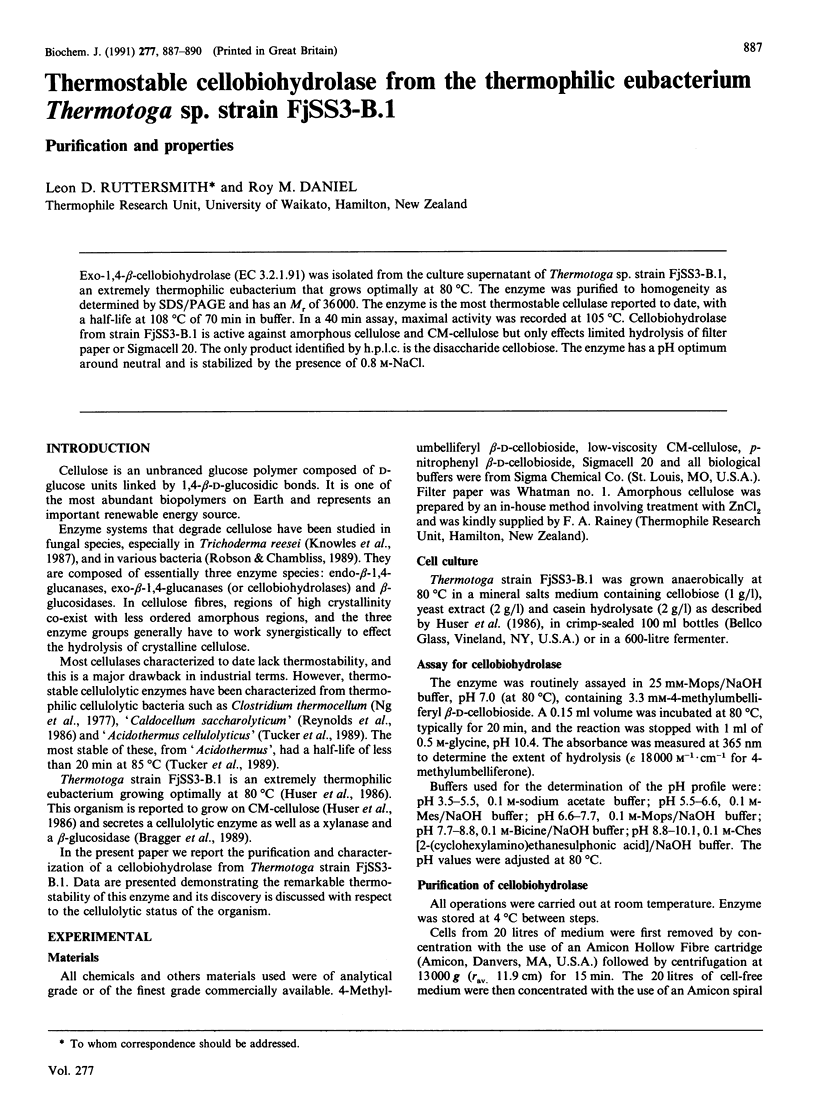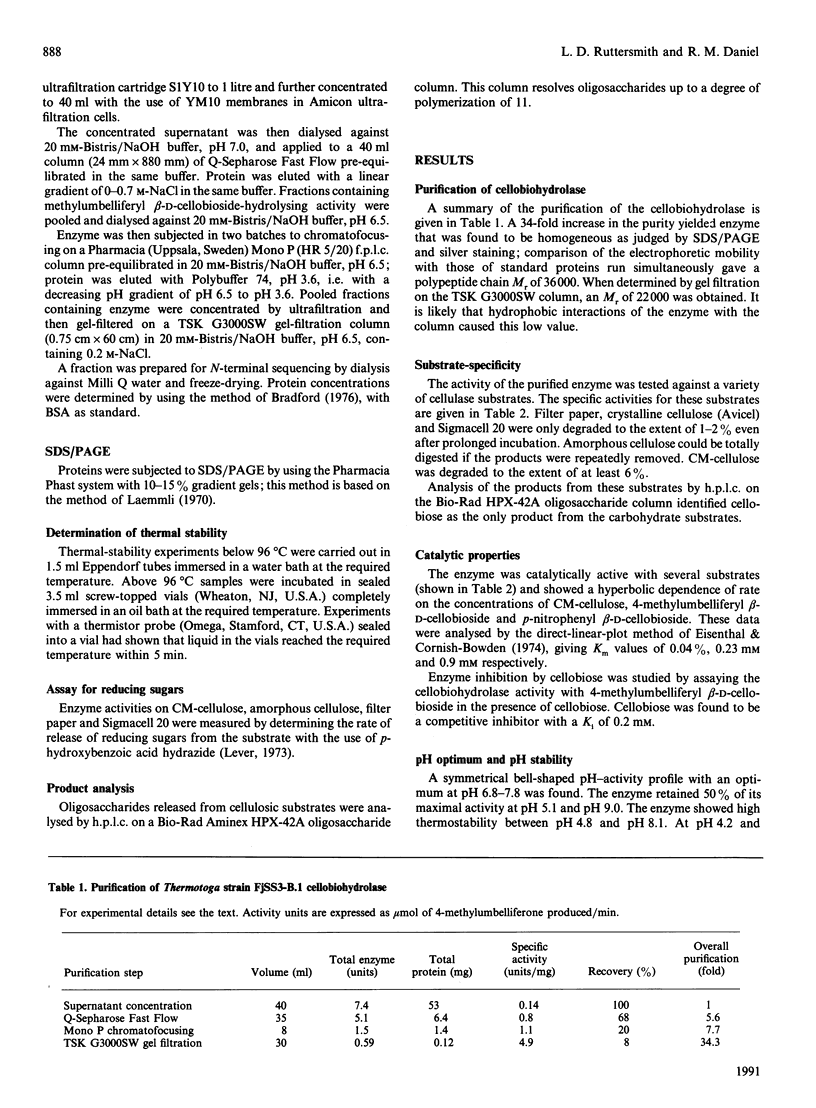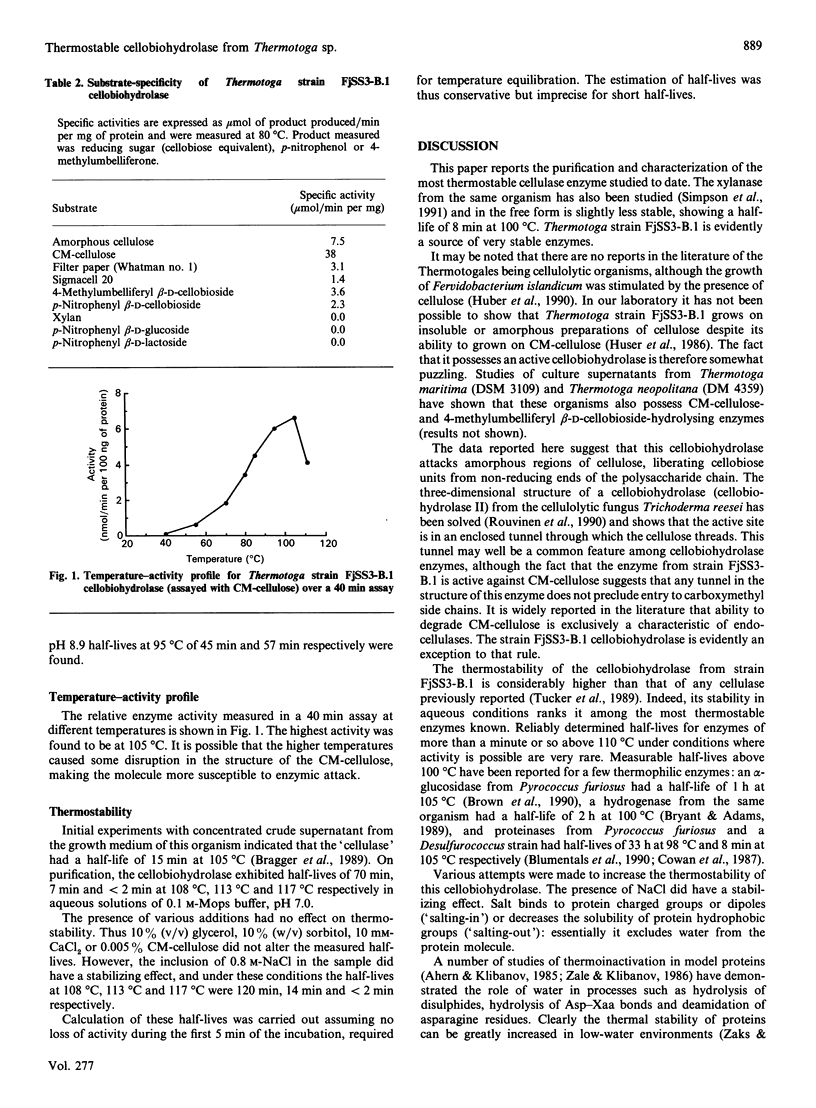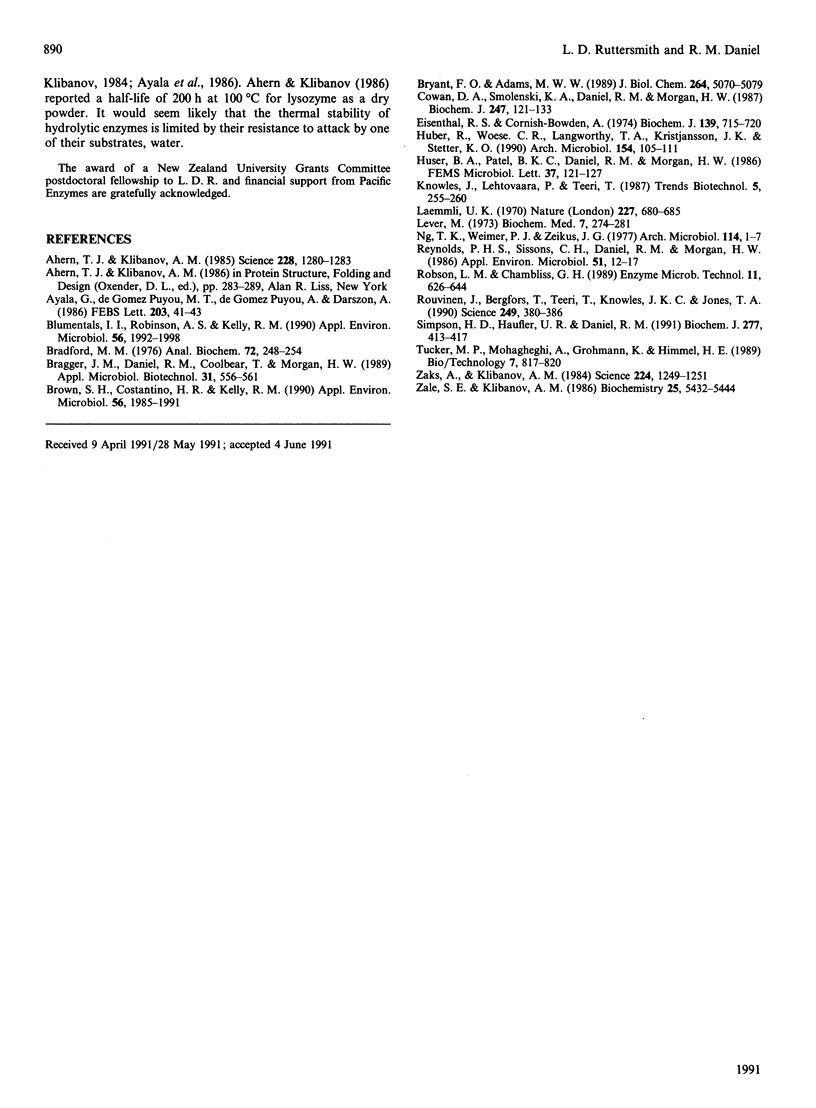Abstract
Exo-1,4-beta-cellobiohydrolase (EC 3.2.1.91) was isolated from the culture supernatant of Thermotoga sp. strain FjSS3-B.1, an extremely thermophilic eubacterium that grows optimally at 80 degrees C. The enzyme was purified to homogeneity as determined by SDS/PAGE and has an Mr of 36,000. The enzyme is the most thermostable cellulase reported to date, with a half-life at 108 degrees C of 70 min in buffer. In a 40 min assay, maximal activity was recorded at 105 degrees C. Cellobiohydrolase from strain FjSS3-B.1 is active against amorphous cellulose and CM-cellulose but only effects limited hydrolysis of filter paper or Sigmacell 20. The only product identified by h.p.l.c. is the disaccharide cellobiose. The enzyme has a pH optimum around neutral and is stabilized by the presence of 0.8 M-NaCl.
Full text
PDF



Selected References
These references are in PubMed. This may not be the complete list of references from this article.
- Ahern T. J., Klibanov A. M. The mechanisms of irreversible enzyme inactivation at 100C. Science. 1985 Jun 14;228(4705):1280–1284. doi: 10.1126/science.4001942. [DOI] [PubMed] [Google Scholar]
- Ayala G., de Gómez-Puyou M. T., Gómez-Puyou A., Darszon A. Thermostability of membrane systems in organic solvents. FEBS Lett. 1986 Jul 14;203(1):41–43. doi: 10.1016/0014-5793(86)81432-6. [DOI] [PubMed] [Google Scholar]
- Blumentals I. I., Robinson A. S., Kelly R. M. Characterization of sodium dodecyl sulfate-resistant proteolytic activity in the hyperthermophilic archaebacterium Pyrococcus furiosus. Appl Environ Microbiol. 1990 Jul;56(7):1992–1998. doi: 10.1128/aem.56.7.1992-1998.1990. [DOI] [PMC free article] [PubMed] [Google Scholar]
- Bradford M. M. A rapid and sensitive method for the quantitation of microgram quantities of protein utilizing the principle of protein-dye binding. Anal Biochem. 1976 May 7;72:248–254. doi: 10.1006/abio.1976.9999. [DOI] [PubMed] [Google Scholar]
- Brown S. H., Costantino H. R., Kelly R. M. Characterization of Amylolytic Enzyme Activities Associated with the Hyperthermophilic Archaebacterium Pyrococcus furiosus. Appl Environ Microbiol. 1990 Jul;56(7):1985–1991. doi: 10.1128/aem.56.7.1985-1991.1990. [DOI] [PMC free article] [PubMed] [Google Scholar]
- Bryant F. O., Adams M. W. Characterization of hydrogenase from the hyperthermophilic archaebacterium, Pyrococcus furiosus. J Biol Chem. 1989 Mar 25;264(9):5070–5079. [PubMed] [Google Scholar]
- Cowan D. A., Smolenski K. A., Daniel R. M., Morgan H. W. An extremely thermostable extracellular proteinase from a strain of the archaebacterium Desulfurococcus growing at 88 degrees C. Biochem J. 1987 Oct 1;247(1):121–133. doi: 10.1042/bj2470121. [DOI] [PMC free article] [PubMed] [Google Scholar]
- Eisenthal R., Cornish-Bowden A. The direct linear plot. A new graphical procedure for estimating enzyme kinetic parameters. Biochem J. 1974 Jun;139(3):715–720. doi: 10.1042/bj1390715. [DOI] [PMC free article] [PubMed] [Google Scholar]
- Laemmli U. K. Cleavage of structural proteins during the assembly of the head of bacteriophage T4. Nature. 1970 Aug 15;227(5259):680–685. doi: 10.1038/227680a0. [DOI] [PubMed] [Google Scholar]
- Lever M. Colorimetric and fluorometric carbohydrate determination with p-hydroxybenzoic acid hydrazide. Biochem Med. 1973 Apr;7(2):274–281. doi: 10.1016/0006-2944(73)90083-5. [DOI] [PubMed] [Google Scholar]
- Ng T. K., Weimer T. K., Zeikus J. G. Cellulolytic and physiological properties of Clostridium thermocellum. Arch Microbiol. 1977 Jul 26;114(1):1–7. doi: 10.1007/BF00429622. [DOI] [PubMed] [Google Scholar]
- Reynolds P. H., Sissons C. H., Daniel R. M., Morgan H. W. Comparison of Cellulolytic Activities in Clostridium thermocellum and Three Thermophilic, Cellulolytic Anaerobes. Appl Environ Microbiol. 1986 Jan;51(1):12–17. doi: 10.1128/aem.51.1.12-17.1986. [DOI] [PMC free article] [PubMed] [Google Scholar]
- Rouvinen J., Bergfors T., Teeri T., Knowles J. K., Jones T. A. Three-dimensional structure of cellobiohydrolase II from Trichoderma reesei. Science. 1990 Jul 27;249(4967):380–386. doi: 10.1126/science.2377893. [DOI] [PubMed] [Google Scholar]
- Simpson H. D., Haufler U. R., Daniel R. M. An extremely thermostable xylanase from the thermophilic eubacterium Thermotoga. Biochem J. 1991 Jul 15;277(Pt 2):413–417. doi: 10.1042/bj2770413. [DOI] [PMC free article] [PubMed] [Google Scholar]
- Zaks A., Klibanov A. M. Enzymatic catalysis in organic media at 100 degrees C. Science. 1984 Jun 15;224(4654):1249–1251. doi: 10.1126/science.6729453. [DOI] [PubMed] [Google Scholar]
- Zale S. E., Klibanov A. M. Why does ribonuclease irreversibly inactivate at high temperatures? Biochemistry. 1986 Sep 23;25(19):5432–5444. doi: 10.1021/bi00367a014. [DOI] [PubMed] [Google Scholar]


